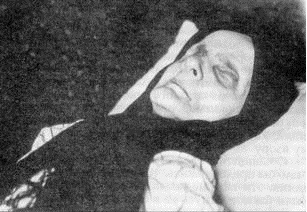Top Qs
Timeline
Chat
Perspective
July 16 (Eastern Orthodox liturgics)
From Wikipedia, the free encyclopedia
Remove ads
July 15 - Eastern Orthodox liturgical calendar - July 17

All fixed commemorations below are celebrated on July 29 by Old Calendar.[note 1]
For July 16th, Orthodox Churches on the Old Calendar commemorate the Saints listed on July 3.
Saints
- Saint Kyriakos the Executioner (Cyriacus), who had beheaded the martyr Antiochus of Sulcis, then converted to Christ and was beheaded (c. 110)[1][2] (see also: December 13)
- Martyr Faustus, by crucifixion, under Decius (c. 249-251)[2][3][4][5][note 2]
- Martyrs Paul and his two sisters Chionia (Thea) and Alevtina (Valentina) at Caesarea Palaestina (308)[7][8][9][10] (see also: July 18)
- Hieromartyr Athenogenes, Bishop of Heracleopolis, and his ten disciples (c. 311)[11][2][4][5][7][12][note 3][note 4]
- Martyr Antiochus of Sebaste, Physician (4th century)[5][7][9][14][15]
- 15,000 Martyrs of Pisidia, who believed in Christ through Saint Marina, by the sword.[2][4][5][7][16]
- Many Holy Women Martyred by the sword.[2][4][5][17]
- Saint Anastasius I, Bishop of Thessaloniki, a father of the Fourth Ecumenical Council (via his representative) (451)[2][18]
- Saint Auxitheus (or Eudoxius), Bishop of Thessaloniki, one of the great Fathers of the Fourth Ecumenical Council (458)[2][19]
Remove ads
Pre-Schism Western saints
- Saint Domnio, a martyr in Bergamo in Italy under Diocletian (c. 295)[20][note 5]
- Saint Valentine of Trier, Bishop of Trier in Germany (or more probably Tongres in Belgium), under Diocletian (c. 305)[20][note 6]
- Virgin-martyr Julia of Carthage, by crucifixion, at Corsica (c. 440)[5][7][9][20][21][22][note 7]
- Martyr Helier of Jersey (6th century)[7][9][20][23][24][note 8]
- Saint Reineldis (Raineldis, Reinaldes) and Companions, martyred by the Huns (c. 680)[20][25][note 9][note 10]
- Saint Generosus, Abbot of Saint-Jouin-de-Marnes in Poitou in France (c. 682)[20]
- Saint Ténénan, Bishop of Léon (7th century)[9][20][24][26][note 11]
- Saint Vitalian of Capua, Bishop of Capua in Italy (7th century)[20][27][note 12]
- Saint Vitalian of Osimo, Bishop of Osimo in Italy (776)[20]
- Martyr Sisenandus Córdoba, a Deacon in the church of St Acisclus in Córdoba in Spain, beheaded under Abderrahman II (851)[5][20][note 13]
- Saint Irmengard (Irmgard of Chiemsee), Abbess of Buchau and then of Chiemsee in Germany (866)[20]
Remove ads
Post-Schism Orthodox saints
- Saint John of Vishnya and Mt. Athos, activist against Uniatism (c. 1630)[7]
- New Martyr John of Turnovo (1822)[7][9]
- Saint Theodotus, monk of Glinsk Hermitage (1859)[7]
New martyrs and confessors
- New Hieromartyrs Nicholas of Tarsus (1917) and his son Habib of Damascus (1948)[28]
- New Hieromartyrs Seraphim, Theognostus, and others of Alma-Ata (1921)[9]
- Venerable Schema-Abbess Magdalena (Dosmanova) of New Tikhvin Convent in Siberia (1934)[7][9][29]
- New Confessor Matrona Belyakova, Fool-for-Christ, of Anemnyasevo (1936)[7][9][10][note 14]
- New Hieromartyrs Jacob (Maskaev), Archbishop of Barnaul,[30][note 15] and Priests Peter Gavrilov and John Mozhirin, and with them Monk-martyr Theodore (Nikitin) and Martyr John (1937)[7][9]
- New Hieromartyr Ardalion (Ponamarev), Archimandrite, of Kasli (Chelyabinsk) (1938)[7][9][10]
Other commemorations
Icon gallery
- Virgin-martyr Julia of Carthage.
- Virgin-martyr Julia of Carthage.
- St. Helier of Jersey.
- Reliquary of St. Irmengard of Chiemsee.
- New Confessor Matrona Belyakova, Fool-for-Christ, of Anemnyasevo.
- New Hieromartyr Jacob (Maskaev), Archbishop of Barnaul.
Notes
- The notation Old Style or (OS) is sometimes used to indicate a date in the Julian Calendar (which is used by churches on the "Old Calendar").
The notation New Style or (NS), indicates a date in the Revised Julian calendar (which is used by churches on the "New Calendar"). - The ten disciples are:
- (in Greek) Ριγίνος, Μαξιμίνος, Πατρόφιλος, Ἀθηνογένης, Ἀντίοχος, Ἄμμων, Θεόφραστος, Κλεόνικος, Πέτρος καὶ Ἠσύχιος.
- Born in Carthage in North Africa, she was sold into slavery by the Vandal conquerors. The ship on which she was being taken to Gaul stopped in Corsica. At that time heathen festival was being celebrated and when Julia refused to join in, she was immediately martyred by being nailed to a cross. She is the patron-saint of Corsica.
- Daughter of St Amelberg and sister of St Gudula. She was a nun at Saintes in Belgium where she was martyred together with two companions by the Huns.
- Probably born in Wales, he became a hermit in Brittany and eventually Bishop of Léon. His relics were enshrined in Ploabennec.
- See: (in Russian) Матрона Анемнясевская. Википедии. (Russian Wikipedia).
- See: (in Russian) Иаков (Маскаев). Википедии. (Russian Wikipedia).
Remove ads
References
Sources
Wikiwand - on
Seamless Wikipedia browsing. On steroids.
Remove ads






